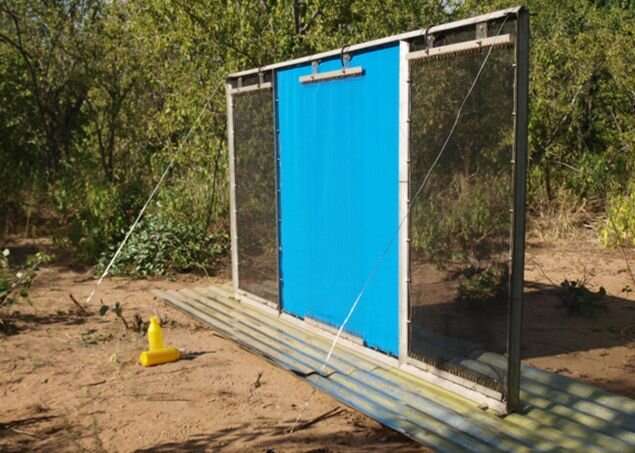For controlling tsetse flies, fabric color matters

Tsetse flies infest an estimated 10 million square kilometers of sub-Saharan Africa and their bites transmit trypanosome parasites that cause disease in humans and in animals. This week in PLOS Neglected Tropical Diseases, researchers report that they have engineered an improved colored fabric for the insecticide-treated targets used to control tsetse, based on an understanding of how flies see color.
Tsetse targets are traditionally made from large panels of black or blue-dyed cotton fabric, sometimes flanked by netting. The target is coated in insecticide so that flies are attracted and once they make contact with it, they are then dosed and killed. Recently it has been realized that polyester targets are lighter, last longer, and hold insecticide better, but some blue polyesters are not as effective in attracting tsetse as cotton equivalents, even though their color may appear similar to a human eye.
In the new work, Roger Santer of Aberystwyth University, and colleagues calculated how a fly's photoreceptors would respond to a variety of colored fabrics to determine the attractive properties of color from a fly's-eye-view. They then deliberately engineered a polyester fabric to be more attractive based upon those principles and tested its effectiveness against savannah tsetse flies. In contrast to traditional assumptions, the new fabric was violet to a human eye rather than blue.
The team compared catches of various polyester targets to a standard one constructed from black cotton. They found that targets made from blue polyesters could be just as effective as black cotton ones, indicating that these modern materials are useful in savannah tsetse control. However, they also found that their new violate polyester attracted approximately 50% more female tsetse than either the traditional black cotton or a typical blue polyester, demonstrating its effectiveness.
"Our results demonstrate that photoreceptor-based models can be used to engineer fabrics with greater attractiveness to tsetse and show that the violet fabric developed in this study is both robust and effective for targets against savannah species," the researchers say.
More information: Santer RD, Vale GA, Tsikire D, Torr SJ (2019) Optimising targets for tsetse control: Taking a fly's-eye-view to improve the colour of synthetic fabrics. PLOS Neglected Tropical Diseases 13(12): e0007905. doi.org/10.1371/journal.pntd.0007905




















